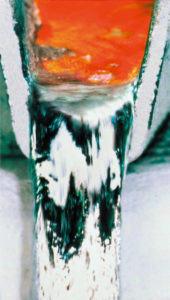The aluminium sector is responsible for 1.1 billion tonnes of greenhouse gas emissions per annum, around 2% of global anthropogenic emissions. According to an International Aluminium Institute (IAI) report, this needs to become 250 Mt CO2e by 2050, while at the same time growing production by up to 80%.
The report, Aluminium Sector Greenhouse Gas Pathways to 2050, sets out three approaches, across the aluminium industry, to target emissions reductions in line with the International Energy Agency’s Beyond 2 Degree Scenario. Decarbonisation of electricity, novel technologies for heat and steam, and zero carbon smelting along with post-consumer scrap recycling rates nigh on 100%.
 The properties of aluminium, such as its strength lightness and durability are suited to many decarbonisation solutions; it is used in solar panels, wind turbines and EVs. As such, the IAI predicts demand to grow by 80% by 2050, this will be met by a combination of recycled and primary aluminium.
The properties of aluminium, such as its strength lightness and durability are suited to many decarbonisation solutions; it is used in solar panels, wind turbines and EVs. As such, the IAI predicts demand to grow by 80% by 2050, this will be met by a combination of recycled and primary aluminium.
The IAI considers that a growing population allied to its increasing range of applications, will rule out the possibility of relying on recycled aluminium with its significantly lower energy and carbon footprint. There will not be enough post-consumer scrap to meet this demand and primary metal will still need to be produced until at least the second half of the century says the report.
The pathways chosen be the IAI to tackle the challenges of simultaneously reducing emissions while meeting increasing demand are:
- Electricity decarbonisation – More than sixty percent of the aluminium sector’s 1.1 billion tonnes of CO2e emissions (2018) are from the production of electricity consumed during the smelting process. Decarbonised power generation and the deployment of carbon capture utilisation and storage (CCUS) offer the most significant opportunity to reduce emissions to near zero by 2050.
- Direct emissions – Emissions from fuel combustion make up 15% of the industry’s emissions. Here, electrification, fuel switching to green hydrogen and CCUS offer the most credible pathways. Process emissions make up a further 15% and require new technologies, such as inert anodes. These emissions and those in transport and raw materials will need to be reduced by 50-60% from a Business as Usual (BAU) baseline scenario by 2050.
- Recycling and resource efficiency – Increasing collection rates to near 100% as well as other resource efficiency progress by 2050 would reduce the need for primary aluminium by 20% compared to BAU, which in turn will cut the sector’s emissions by an additional 300 million tonnes of CO2e per year – a figure second in magnitude only to the first pathway, electricity decarbonisation.
Download the full report here.



